MARIANI’S
January 29, 2006
NEWSLETTER
"Custard Mustard 'n Brew," Saranac Lake, NY, 2005 Photo by Galina Stepanoff-Dargery
UPDATE: To
go to my web site, in which I will update food
&
travel information and help link readers to other first-rate travel
& food sites, click on: home page
ACCESS TO
ARCHIVE: Readers may now access
an
Archive of all past newsletters--each annotated--dating back to July,
2003, by simply clicking on www.johnmariani.com/archive
.
NEW
FEATURE! You may now subscribe anyone you wish
to this newsletter by
clicking here.
In
This Issue
TIME FOR ICE WINES by John Mariani
NEW YORK CORNER: Peacock Alley at the Waldorf Re-Opens by John Mariani
QUICK BYTES
~~~~~~~~~~~~~~~~~~~~~~~~~~~~~~~~~~~~
LA CUCINA DI ROMA Part I
by John Mariani
La Fontana del Nettuno by Lorenzo Bernini in Rome's Piazza Navona
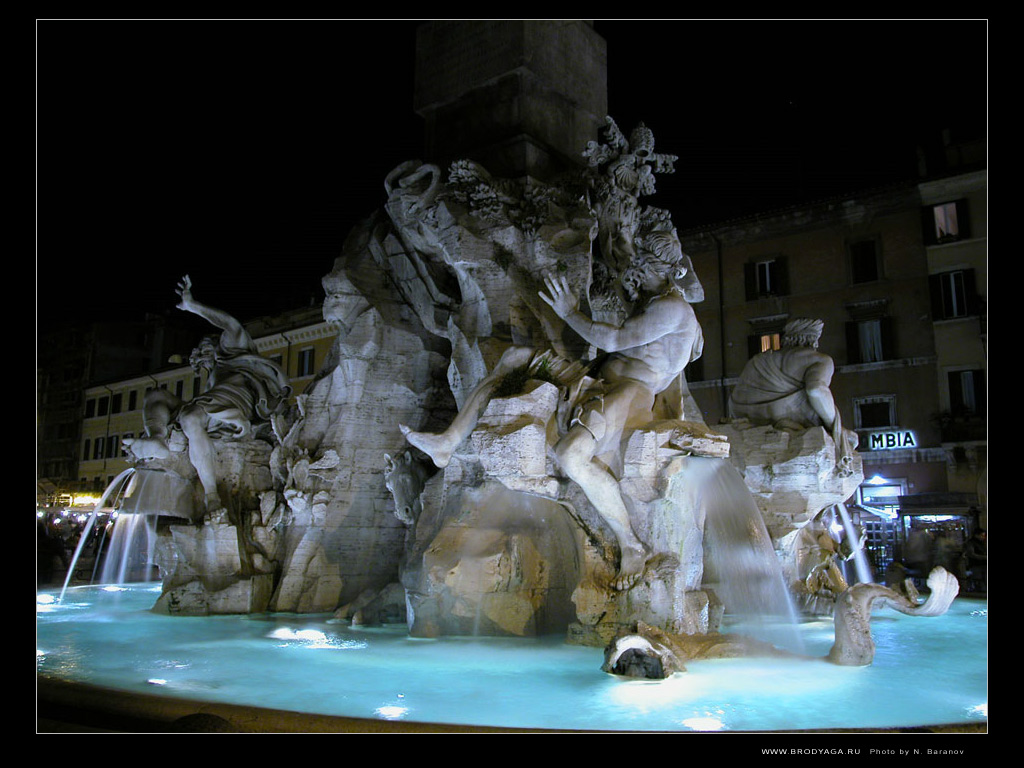
Even the Roman historian Livy complained in 14 A.D. of his city's “self-indulgence in every form of sensual excess," which doesn’t sound all that terrible to me.
True, Florence has more style, Venice more magic, Naples more of the baroque, and Milan is more mannered. But for me Rome is unquestionably the greatest of Italian cities for all the reasons its critics carp about as well as for all the reasons that make it unique--from the block-by-block evidence of a 2,800-year-old civilization to the majesty of the Vatican. And when it comes to dining out, I think Roman cooking is far more interesting than that of Florence, Milan, even Bologna, where the food is, however delicious, more regional and smaller in its range.
The truth of the adage, "When in Rome, eat as the Romans do" is obvious when you sit down with the locals and observe the gusto with which they enjoy their food at both the posh ristoranti and the no-longer-so-humble trattorie. Roman food is hearty, simple, seasonal, allied to the Mediterranean, but never as heavy as Italian-American food. Romans love olive oil, adore sauces made with tomato, pork and onions, and feast on ancient dishes like oxtail stew and lamb offal sautéed in lard. It is not food for the faint of heart or stomach, yet Romans tend to keep their bella figura long after American tourists have gone to pot.
Owned by the Wirth family for five generations, The Hassler served as the Rome headquarters for the U.S. Army Air Force during World War II and re-opened in 1947 with a posh, new post-war Italian décor and an international clientele. Through its revolving doors has come the whole world—Tom Cruise and Katie Holmes romped here while in Rome—and the concierges perform more miracles than the Pope at the request of guests who are as demanding as they can be eccentric.
There are 86 rooms at the Hassler, 10 deluxe suites, and three Presidential suites, one of which was occupied by John and Jackie Kennedy, whose table is still pointed out by the maître d’ at the glorious al fresco Rooftop Terrace restaurant (above). Here you sit sipping a Negroni or a glass of cold prosecco and gaze out on the vast city, starting with the adjacent Trinità dei Monti church that looks down on the sprawl of young people swarming the Spanish Steps. The hokey grandeur of the Victor Emmanuel II monument and the splendor of the Piazza Navona lie beyond, the cool greenery of the Borghese Gardens is to your right, and all the glowing marble domes of Rome’s churches and St. Peter’s are spread across the horizon.
In the dining room you choose from a menu of Italian cuisine like prawns with Sicilian couscous and fresh mozzarella, Campanian pasta with seafood and yellow-gold zucchini flowers, and a roasted bass with eggplant and ginger, and you treat yourself to a very fine barbaresco.
At twilight the intense blue of Rome’s sky softens into a band of pink and fiery orange punctuated by the city’s steeples and spires. The lights of Rome’s monuments come up to mimic the incandescence of the moon, and everyone in the streets seems in the throes of la dolce vita until the church bells toll at midnight.
Afterwards you may retire to a lovely room in the palazzetto itself (right) and fall asleep listening to the sounds and music of Rome right outside your window. It is an enchanting spot and the education is a joy under Mr. D'Agata.
There is a widespread opinion, however, that the best coffee in the city is at Sant'Eustachio (82 Piazza Sant'Eustachio; click)
 near the
Pantheon. It is not a particularly picturesque place, in a not
particularly picturesque piazza, but its
triumph is in the secret of its "Gran
Cappuccino" shown in the photo at
the right. I suspect there is some caramelization of the sugar, but
from top to bottom it is a snowy, creamy, undeniably rich and wholly
complex cup of coffee. Again, have it inside, not at a piazza
table, where it is more expensive.
near the
Pantheon. It is not a particularly picturesque place, in a not
particularly picturesque piazza, but its
triumph is in the secret of its "Gran
Cappuccino" shown in the photo at
the right. I suspect there is some caramelization of the sugar, but
from top to bottom it is a snowy, creamy, undeniably rich and wholly
complex cup of coffee. Again, have it inside, not at a piazza
table, where it is more expensive.On the other hand there is a growing number of enthusiasts who contend that Ciampini (29 Piazza
If you're considering a light lunch, head for Obikà Mozzarella Bar on the Piazza Firenze (06-683-2630). The name is Neapolitan slang for “Here it is,” and you certainly get the feeling of being in the place of the moment when you arrive. Sleek, modern, with huge windows fronting an outdoor dining section and an interior with what at first glance appears to be a Japanese sushi bar, Obikà is instead a bar where you may order an array of regional buffalo mozzarellas (below). In the next room is a wall of wines chosen to go with the food here. It’s all high concept, so don’t be surprised if an Obikà opens in
Sitting outside under a white umbrella sipping a good frascati, and gobbling up slices of mozzarella and salume here, its tables deliberately close to one another for sheer conviviality, is not a bad way to spend an afternoon’s lunch, rising from it with just enough energy to stroll over to Rome’s best ice cream store, Il Gelato di San Crispino near the Trevi Fountain (42 Via della Pantelleria; 06-67-93-924; two other locations).
Here you don’t find the plenitude of gelati other places display. Instead, there is a relatively small selection of very rich, satin-textured ice creams in very unusual flavors like Armagnac cream with lemon sorbetto; chestnut with Rhum Clément; hazelnuts and figs with chocolate and rum, and honey laced with whiskey, along with the more usual vanilla, chocolate, fruit gelati and sorbetti. A small coppa of San Crispino’s gelato sends you back into the streets convinced you have enjoyed something of
For your first dinner in Rome, I heartily recommend La Campana (18 Vicolo della Campana; 06-686-7820) near the Tiber. There are fancier ristoranti in Rome, and the city is full of regional Italian eateries from Campania, Tuscany, and Lombardy. But the heart and soul—and belly—of Rome are in its native trattorias whose owners have run them for ages and whose clientele speaks in the sing-song accents of their local neighborhoods. La Campana, not far from the Spanish Steps, calls itself the oldest trattoria in Rome, its menu proudly tracing the restaurant’s lineage back to 1518. Indeed, I suspect that, except for its electric lights, La Campana probably looks about the same as it did in the Nineteenth Century. It is a big bustling place with two rooms, with even less décor than most trattorias, just sturdy tables and chairs, fleet-footed waiters, and a menu of Roman specialties made with the kind of consistent goodness and wholesomeness that only comes from centuries’ of perfecting each dish.

There is a winelist, but most of the locals order a carafe of the fresh cold local white called frascati to go with a first course of mixed antipasti—a platter of your choosing of sweet shiny red and yellow peppers, tiny stewed onions, cream-colored buffalo mozzarella, sheer sheets of smoked swordfish, chickpeas in olive oil, thin green beans, and much more.
Then you have to decide among pastas like ravioli with roasted artichokes, rigatoni with a spicy amatriciana sauce made with pork cheek, hot peppers, onion, and tomato, or the glory of Roman cooking, spaghetti alla carbonara, in which raw eggs are cooked by the heat of the pasta itself, along with onions and bacon, into a silky tangle of pure pleasure.
Rome has better seafood than it’s given credit for, but the best things on La Campana’s menu are old-fashioned meats, like trippa alla romana, a rich tripe stew with tomato and cheese, or coda alla vaccinara, oxtail stew—two items I admit may not be for every taste. But there is also abbacchio arrosto—the special baby lamb fed on herbs on the Roman hillsides. Roasted to perfect succulence, it comes in pieces steaming to the table, with crisp skin and velvety tender meat suffused with garlic and rosemary. Pork ribs are nudged by yellow cornmeal called polenta. Pick up the hot ribs with your fingers and nibble them down to the bone, just like everyone else around you is doing.
As at most trattorias, desserts are second thoughts here, so better to go with the frutti di bosco—ripe fruits—perhaps with a slice of buttery Parmigiano or the sharp pecorino for which Rome is famous. Then you quickly sip your sweet espresso with the flippancy all Italians do, and perhaps order an amaro with a name like Ramazzotti or Cynar—bittersweet digestives the color of mahogany.
You pay your bill, which won’t come to very much, wave “ciao-ciao” to the little Roman children smiling at you from the next table, and you walk out to a chorus of “grazies” from the staff. By the time you reach the door, your table has been re-set and re-occupied.
You feel full but not stuffed, happy and content that you have eaten at one of the most historic trattorias in a city whose own history pre-dates it by two more millennia. And then you stroll awhile, arm in arm, nodding to the passersby on the way to see the Tiber or the Spanish Steps in the moonlight, flush with the feeling of having had a true bella notte.
Part II will appear next week, February 5.
by John Mariani
If the legend seems too pat, there’s no question that a passion for ice wines developed first in Germany and Austria, where sweet wines made from late harvested but never frozen grapes have long been an established part of viniculture. Wines labeled beerenauslese and trockenbeerenauslese, however, are usually attacked in the fall by the botrytis fungus called in Germany Edelfäule (“Noble Rot”), which also concentrates the sugars, balanced by minerals and acid, just like Bordeaux’s famous Sauternes. Eisweins, on the other hand, are not attacked by the Edelfäule, and they are pressed with ice crystals still within them. They can be as sweet as botrytis-affected wines, but they tend to be richer, more like a liqueur, and are savored as a dessert wine, or as dessert all on their own.
The picking of the frozen grapes is carefully monitored, for frozen temperatures
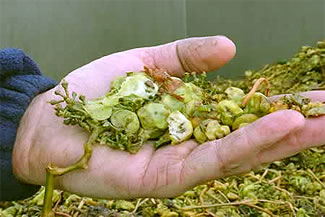 don’t visit German
vineyards much
before the third week in November, and to wait for freezing
temperatures—even
until February—is risky business, because the grapes might just wither
away or be
eaten by birds (netting is usually placed over selected vineyards).
Even then
the grapes are carefully plucked from the vine by hand, discarding the
majority
that have gone bad, resulting in a yield that may be only 5-10 percent
of the
entire crop. After pressing, the wines are aged for a few months, and
the
alcohol level stops naturally between 10-12 percent.
At that point you can certainly enjoy the
freshness and fruited character of an ice wine, though it will age and
take on
more bittersweet, caramel-like nuances over many years.
don’t visit German
vineyards much
before the third week in November, and to wait for freezing
temperatures—even
until February—is risky business, because the grapes might just wither
away or be
eaten by birds (netting is usually placed over selected vineyards).
Even then
the grapes are carefully plucked from the vine by hand, discarding the
majority
that have gone bad, resulting in a yield that may be only 5-10 percent
of the
entire crop. After pressing, the wines are aged for a few months, and
the
alcohol level stops naturally between 10-12 percent.
At that point you can certainly enjoy the
freshness and fruited character of an ice wine, though it will age and
take on
more bittersweet, caramel-like nuances over many years.While German and Austrian eisweins have long been imported into the U.S., they have for the most part remained little more than golden curiosity pieces. Those who love sweet German wines are more likely to go for the more complex levels of flavor in an aged trockenbeerenauslese, which can be very costly indeed, well in excess of $100 a bottle. Eisweins offer a less expensive alternative and a rush of flavor that is uniquely their own.
But North American winemakers are nothing if not curious, so several—most auspiciously, Canadians—are now producing some remarkable ice wines that can compete with the best out of the Germanic countries. And, being experimental, these Americans have tried different grape varieties beyond the usual Riesling used in Europe. Most prominent of these new ice wines are those from the Canadian vintner Inniskillin, with vineyards both on the Niagara Peninsula in Ontario and the Okanagan Valley in British Columbia—both cool climates that can turn to freezing temperatures conducive to making ice wines. Indeed, since Canada is not known for its fine table wines, the arrival a few years ago of these ice wines from across the border surprised connoisseurs, not only for the wines’ brightness and intensity, but for their varietal distinctions, since Inniskillin makes ice wines from Riesling, Vidal, Gewürztraminer, and even the red grape Carnet Franc, which produces a lovely rose-colored, spicy, floral ice wine.
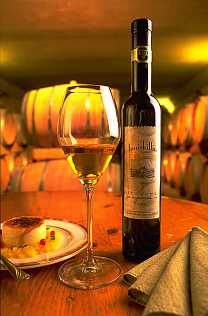 In a tasting of two dozen ice wines, I found
Inniskillin’s
entries
among the very best, some almost candy-like but with acid enough not to
be
cloying after two sips. The Vidal
was
like cotton candy, with flavors of peach and nectarines, while the
often
too-pronounced flavor of Gewürztraminer was pleasantly subdued by
the sweetness
of the wine made from it.
In a tasting of two dozen ice wines, I found
Inniskillin’s
entries
among the very best, some almost candy-like but with acid enough not to
be
cloying after two sips. The Vidal
was
like cotton candy, with flavors of peach and nectarines, while the
often
too-pronounced flavor of Gewürztraminer was pleasantly subdued by
the sweetness
of the wine made from it.New York State also is now producing ice wines of good caliber, especially in the Finger Lakes and in the state of Washington. Of those I tasted I liked most Standing Stone Vidal 2002 from the Finger Lakes, with a green-gold color and lovely vanilla nuances; the best of the Washington ice wines was a Covey Run 2002 Reserve Riesling, which is more medium sweet, with tangy, citrus flavors to balance things. My favorite among the German entries was a Johannes Selbach Oster Zelt Himmelweiss Riesling 2001, a very pretty example of a traditional eiswein with real breeding, though at $115, a lot more than comparable Canadian and U.S. ice wines, which can be had for $20 up to about $75. And the North American bottles are a lot more distinctive in design too.
The true measure of a contemporary ice wine is not, however, in being an extreme form of curiously crafted sweet wine; it is in its adaptability to so many grapes in order to provide so many tastes and pleasures, enjoyed in a few, luscious sips, without too much alcohol in the bargain. No longer rarities, ice wines have become gem-like luxuries.
NEW YORK CORNER
by John Mariani
Peacock Alley Re-Opens at the Waldorf
by John Mariani
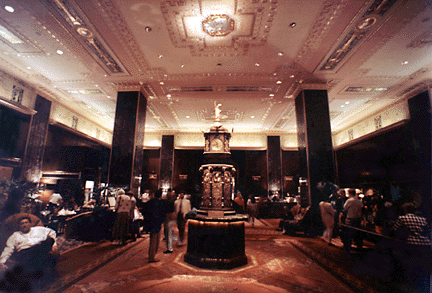 Like anyone
who has ever walked through the great lobby of the Waldorf Astoria (left), I
felt terrible when they closed their main dining room, Peacock Alley,
four years years ago, despite its food getting rave reviews pretty
much across the board. But the nettlesome taint of being a
"hotel dining room," tucked away to the left of the lobby in a room
that seemed better fitted for banquets, simply distanced a lot of
people who might otherwise have gone there for the wonderful food.
Like anyone
who has ever walked through the great lobby of the Waldorf Astoria (left), I
felt terrible when they closed their main dining room, Peacock Alley,
four years years ago, despite its food getting rave reviews pretty
much across the board. But the nettlesome taint of being a
"hotel dining room," tucked away to the left of the lobby in a room
that seemed better fitted for banquets, simply distanced a lot of
people who might otherwise have gone there for the wonderful food.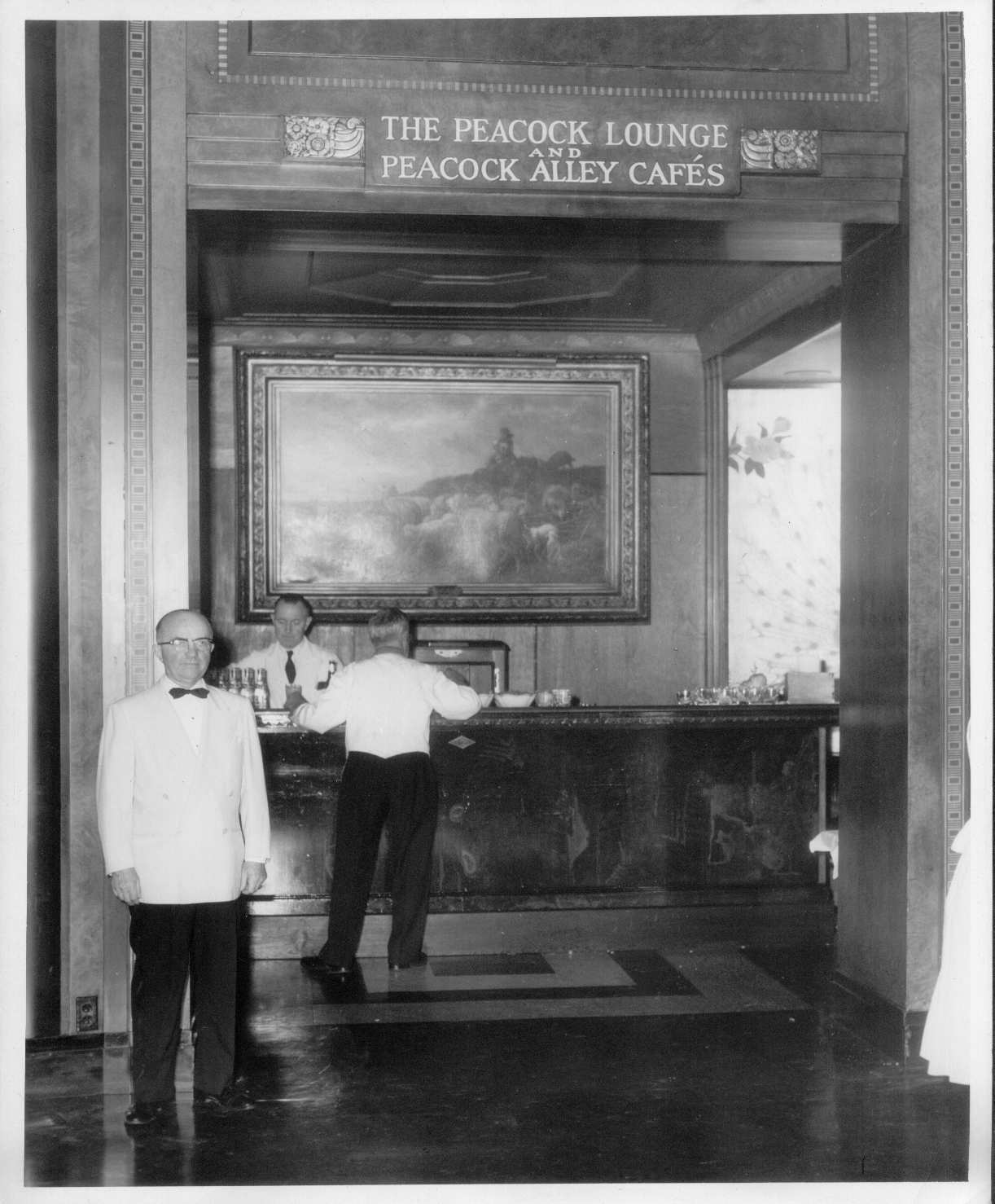
The original Peacock Alley was in the first Waldorf-
The current Waldorf-Astoria opened in 1931, during the Depression and Prohibition (there were no plans for a wine cellar because they could serve no wine). At first, a hallway off the lobby took on the name Peacock Alley, transferred in 1961 to the restaurant (right). The events of 9/11 made its closing inevitable, but now, after a $5.5 million renovation that still admirably maintains the art deco style, with a 30-foot-long bar with cast-glass female silhouettes and murals depicting peacocks reclaimed from the former restaurant and inserted in the private dining rooms and lounge areas and marble pillars replicated after pieces already in the main lobby, it is a spectacular setting.
What is most daring about the new Peacock Alley, despite the fact that isn't in an alley, is that management has gone wholly against the entrenched wisdom that locating a fine dining restaurant right up against a lobby is fit more for a Marriott or Hilton than the Waldorf-Astoria (pssst! Hilton actually owns the Waldorf). But I think it's a brilliant stroke: were this not so majestic a lobby, watching the comings-and-goings of arrivals and departees might be depressing as hell. But this is the grand lobby of the Waldorf!!! and the comings-and-goings are endlessly fascinating, all within a space of daunting majesty that never loses its ability to awe even a jaded New Yorker. Flanking the famed nine-foot-high, two-ton clock (first exhibited at the 1893 Chicago World's Fair) that chimes every 15 minutes, the restaurant is part of a wondrous swirl of activity, making me wonder why no one's ever thought of this before. (The Waldorf is also home to the restaurants Bull & Bear, Inagaku, and Oscar's.)
 In line with the talents of
Peacock Alley's recent chefs, who have included Laurent Gras (now at
Bistro du Vent) and
Laurent Manrique (at Aqua in San Francisco), management has brought in
a superb young talent,
Cedric Tovar (below), most
recently of Django in NYC and before that at Jamin,
La Tour d'Argent, and the Plaza-Athenée in Paris.
In line with the talents of
Peacock Alley's recent chefs, who have included Laurent Gras (now at
Bistro du Vent) and
Laurent Manrique (at Aqua in San Francisco), management has brought in
a superb young talent,
Cedric Tovar (below), most
recently of Django in NYC and before that at Jamin,
La Tour d'Argent, and the Plaza-Athenée in Paris.This is a staff heavy in talent and experience. The general manager is Jean-Pierre Duteron, formerly maître d' to Francois Mitterand, assisted by senior manager and sommelier Evelyn Hsu, formerly at Mercer Kitchen and 66, who maintains a 200-label list, with about 15 selections by the glass. Nevertheless, they really should improve the winelist, which is not now stellar except in its sky-high pricing: A dreary commercial wine like Santa Margherita Pinot Grigio at $68 is either an attempt to dissuade people from drinking this insipid stuff or a real gouge to those who like it.
Tables are beautifully set with Bernardaud and Rosenthal china, Schott Zwiesel and Stölzle glassware, Sambonet flatware, and lovely glass table lanterns by Adrien Linford. A fine pianist performs with impeccable taste on a nearby piano. Most--not all, alas--men wear jackets.
It isn't easy to choose among a dozen tempting appetizers that begin with a wintry chestnut soup with apple and a garlic beignet (which, of course, you'll want more of). A lovely salad of candy cane and yellow beets gets the addition of goat's cheese fritters and a beet vinaigrette, while most delightful of all is a loin of Spanish mackerel with a mild onion-anchovy compote and balsamic vinegar (below, right). If any dish promised to be assertively fishy, this was it, but this was not, a remarkably delicate, buttery texture and flavor achieved instead. Very good, though a tad salty one evening, was a slowly poached egg with black truffle, a mushroom truffle sauce, and crispy pancetta bacon. Braised pork cheeks and a parmesan emulsion graced garganelli pasta, which could have used more oomph.
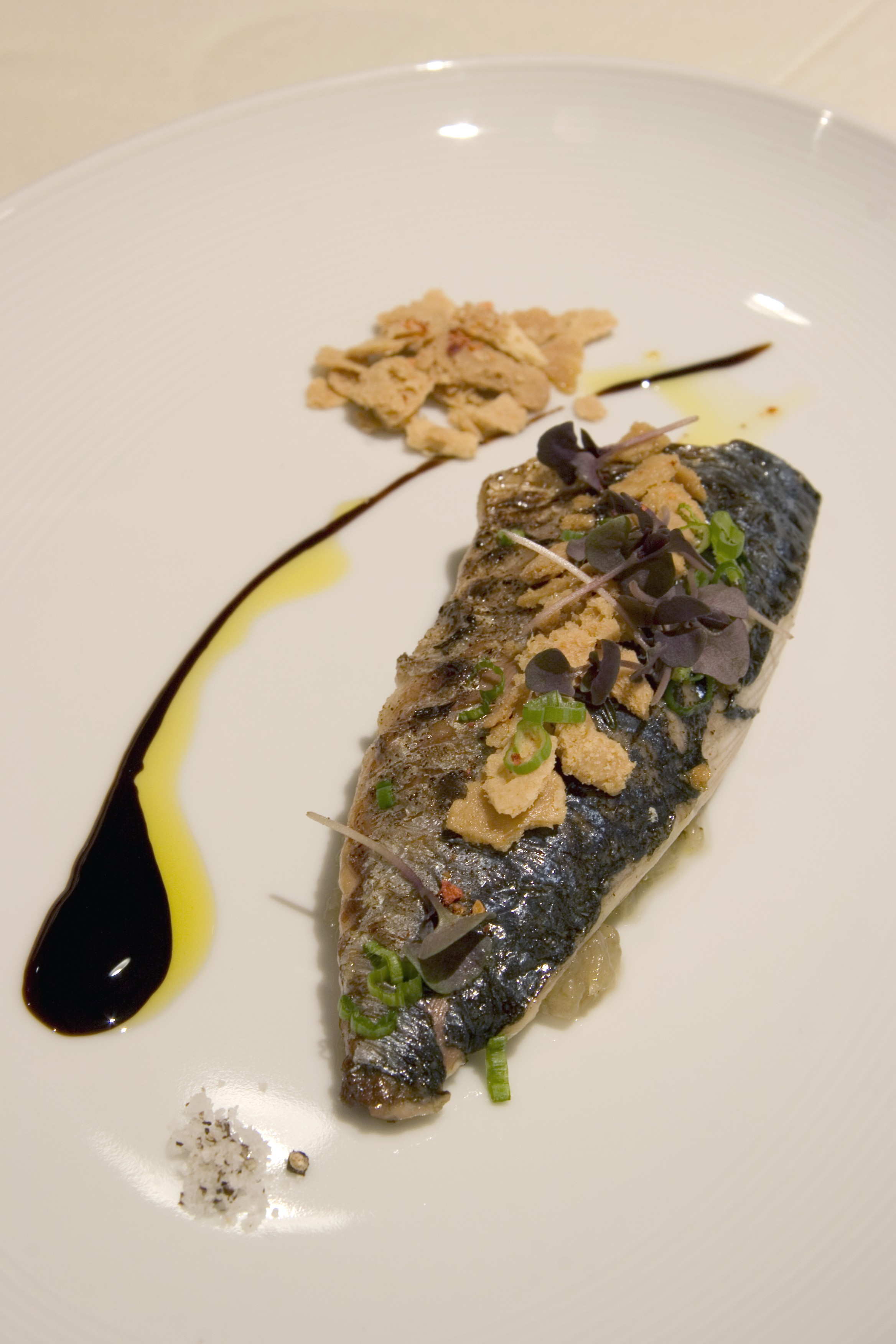
For the main courses I recommend the excellent pork loin marinated in "wild" pepper (what is that?), with sweet baked onion and a lovely parsnip purée, Also delicious was guinea hen--rarely seen in upscale restaurants--with plenty of flavor, served with salsify and the bird's thigh stuffed with mushrooms, all adrift in a light, ginger consommé. The finest entree I tasted was duck of marvelous flavor and succulence, served with winter's braised turnips, sweet potatoes, and a duck leg roesti--fabulous dish! Not quite fabulous was a bland, overcooked halibut in a mussel-soffrito with roasted artichokes and lemon confit.
If you really want them by all means have the pretty pots of side orders ($9 each) like mashed potatoes, wild mushrooms, and root vegetable fricassée.
I am so happy to have Peacock Alley back and particularly for where it's located, right off the lobby. Having recently watched a 1945 movie called "Weekend at the Waldorf," with Walter Pidgeon, Ginger Rogers, Van Johnson, and Lana Turner, which was extensively filmed at the hotel itself, there was a sense that this has been a very special place for so long as to be very much part of New York social history. With the restoration of Peacock Alley, it reigns still as the most glamorous of all New York hotels.
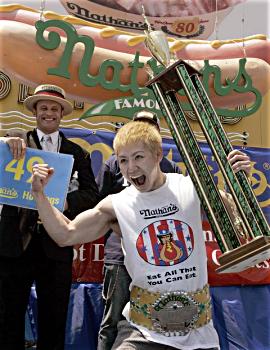
DEPARTMENT OF WRETCHED EXCESS
NEW HOPE FOR FEMALE ENTOMOLOGISTS VISITING ITALY
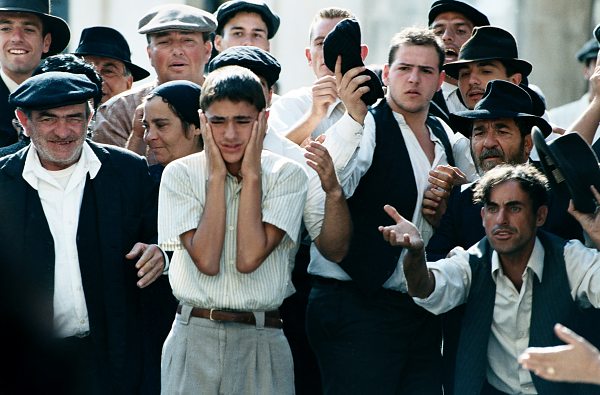
* “Italian Cinema Afternoon & Evenings” come to Baglioni Hotel London, beginning Jan. 29 and following the first Sunday of every month. Guests will enjoy traditional Italian Tea and/or an Italian 3-course dinner followed by screenings of classic Italian films, such as ‘La Vita e Bella’, ‘Cinema Paradiso’, ‘La Dolce Vita’, and ‘Il Postino,’ with Peroni, Chianti and Morelli’s Italian ice cream and popcorn will be flowing. £25 for tea, while evening Screening; 3-course Dinner, £28 pp. . . . Additionally, the Hotel will be launching “Picnics in the Park” and “Bicycles in the Park” throughout the Spring, Summer and into early Fall, prepared by Chef Stefano Stecca of the Brunello Restaurant.
* For the entire month of February, Lark Creek Restaurant Group's seven Bay Area restaurants ushers in their 17th Annual Crab Festival., with chefs showcasing menus that feature seasonal crab dishes: Restaurants incl. The Lark Creek Inn in Larkspur, One Market in San Francisco, Lark Creek Walnut Inn, Yankee Piers in Larkspur, Santana Row, and SFO Airport, and PARCEL 104 in Santa Clara.
* On Feb. 3, French hotelier and Chef Xavier Mathieu of Le Phebus in
*On Feb. 4, at the Rock Financial Showplace in
* On Feb. 7
* From Feb 7-11 NYC’s Carlyle Hotel welcomes Italian Chef Stefano Baiocco of Villa Feltrinelli on Lake Garda (visit: www.villafeltrinelli.com) for a ‘Taste of
* Terrance Brennan and the masters of cheese at NYC’s Artisanal Fromagerie and Bistro will feature Fondue Month, with a different cheese fondue for every day in February, served as Petite (for 1-3 people) or Grande (for 4-6 people) at $24 and $40 respectively. Call 212-725-8585.
* February will be “Choucroute Month” at NYC’s Les Halles restaurants at 411 Park Avenue South (212-679-4111
* From Feb. 16-26 Montreal will once again host some of the best chefs on the international scene with the Seventh edition of The MONTREAL HIGH LIGHTS Festival, featuring this year chefs and wine producers from Alsace and Vancouver, with Émile Jung of Au Crocodile in Strasbourg serving as Honorary President and hosting a dinner at the Beaver Club in the Fairmont Le Reine-Elizabeth Hotel in tandem with Chef Alain Pignard. Chefs from about 50 of
MARIANI'S VIRTUAL GOURMET NEWSLETTER is published weekly. Editor/Publisher:
John Mariani. Contributing Writers: Robert Mariani, Naomi
Kooker, Kirsten Skogerson, Edward Brivio, Mort
Hochstein, Lucy Gordan, Suzanne Wright. Contributing
Photographers: Galina Stepanoff-Dargery, Bobby Pirillo. Technical
Advisor: Gerry McLoughlin.
Any of John Mariani's books below
may be ordered from amazon.com by clicking on the cover image.
 |
 |
 |
 |
 |
 |
copyright John Mariani 2006